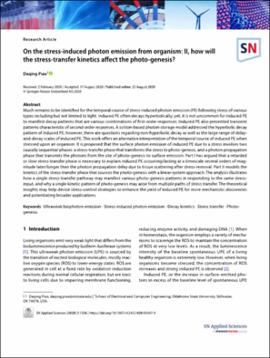| dc.contributor.author | Piao, Daqing | |
| dc.date.accessioned | 2023-07-06T21:30:16Z | |
| dc.date.available | 2023-07-06T21:30:16Z | |
| dc.date.issued | 2020-08-25 | |
| dc.identifier | oksd_piao_on_the_stress_induced_part2_2020 | |
| dc.identifier.citation | Piao, D. (2020). On the stress-induced photon emission from organism: II, how will the stress-transfer kinetics affect the photo-genesis?. SN Applied Sciences, 2(9), 1556. https://doi.org/10.1007/s42452-020-03347-0 | |
| dc.identifier.issn | 2523-3963 | |
| dc.identifier.uri | https://hdl.handle.net/11244/337905 | |
| dc.description.abstract | Much remains to be identified for the temporal course of stress-induced photon emission (PE) following stress of various types including but not limited to light. Induced PE often decays hyperbolically; yet, it is not uncommon for induced PE to manifest decay patterns that are various combinations of first-order responses. Induced PE also presented transient patterns characteristic of second-order responses. A soliton-based photon-storage model addressed the hyperbolic decay pattern of induced PE; however, there are questions regarding non-hyperbolic decay as well as the large range of delay-and-decay scales of induced PE. This work offers an alternative interpretation of the temporal course of induced PE when stressed upon an organism. It is proposed that the surface photon emission of induced PE due to a stress involves two causally sequential phases: a stress-transfer phase that transforms the stress to photo-genesis, and a photon-propagation phase that transmits the photons from the site of photo-genesis to surface emission. Part I has argued that a retarded or slow stress-transfer phase is necessary to explain induced PE occurring/lasting at a timescale several orders of magnitude later/longer than the photon propagation delay due to tissue scattering after stress-removal. Part II models the kinetics of the stress-transfer phase that sources the photo-genesis with a linear-system approach. The analysis illustrates how a single stress-transfer pathway may manifest various photo-genesis patterns in responding to the same stress-input, and why a single kinetic pattern of photo-genesis may arise from multiple paths of stress transfer. The theoretical insights may help devise stress-control strategies to enhance the yield of induced PE for more mechanistic discoveries and potentiating broader applications. | |
| dc.format | application/pdf | |
| dc.language | en_US | |
| dc.publisher | Springer Nature | |
| dc.relation.ispartof | SN Applied Sciences, 2 (9) | |
| dc.rights | This material has been previously published. In the Oklahoma State University Library's institutional repository this version is made available through the open access principles and the terms of agreement/consent between the author(s) and the publisher. The permission policy on the use, reproduction or distribution of the material falls under fair use for educational, scholarship, and research purposes. Contact Digital Resources and Discovery Services at lib-dls@okstate.edu or 405-744-9161 for further information. | |
| dc.title | On the stress-induced photon emission from organism: II, how will the stress-transfer kinetics affect the photo-genesis? | |
| dc.date.updated | 2023-07-02T13:23:11Z | |
| dc.note | open access status: Bronze OA | |
| dc.identifier.doi | 10.1007/s42452-020-03347-0 | |
| dc.description.department | Electrical and Computer Engineering | |
| dc.type.genre | Article | |
| dc.type.material | Text | |
| dc.subject.keywords | particle and high energy physics | |
| dc.subject.keywords | physical sciences | |
| dc.identifier.author | ORCID: 0000-0003-0922-6885 (Piao, D) | |
| dc.identifier.author | ScopusID: 7005153312 | 57220465193 (Piao, D) | |
| dc.identifier.author | ResearcherID: I-1341-2013 (Piao, D) | |
| dc.identifier.essn | 2523-3971 | |
